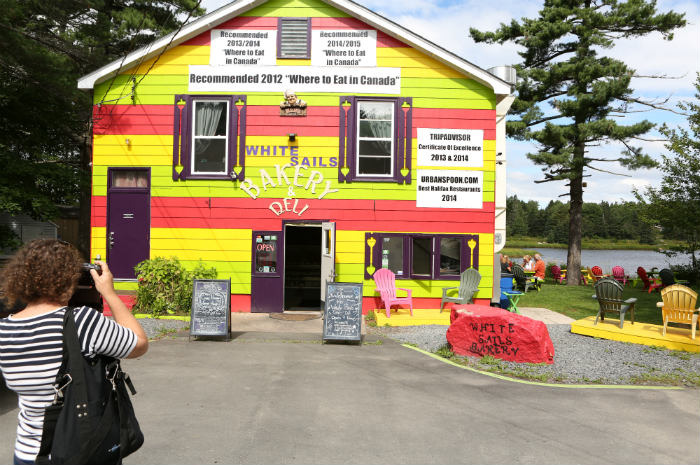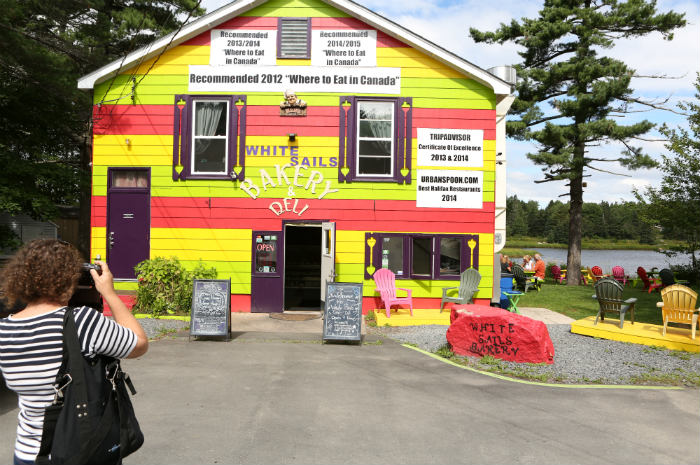Seafood, Wine, And Scenery: A Delectable Journey Through Southwestern Nova Scotia, Part 1
Practically every town you visit as you drive along Nova Scotia's southern coast is described as "seafaring," highlighting the importance of the fishing industry to this rugged province. Foodies will enjoy fresh seafood, artisan cheeses and locally grown fruits and vegetables, set off by the award-winning wines of this region. History buffs will love visiting a Loyalist town and Acadian villages. And everywhere you go there will be friendly faces making you feel welcome.
Halifax
I started my culinary exploration of southwestern Nova Scotia in Halifax. The capital of Nova Scotia has many attractions, but I spent my time wandering around Halifax Harbor's waterfront boardwalk, working up an appetite for some fresh seafood. The boardwalk is about a mile and a half long, and if the view of boats dotting the sparkling water palls, you can always stop in at one of its three maritime-related museums or even a casino.
I stopped in at McKelvie's, which is located just a block from the Lower Water Street. This seafood restaurant has been a Nova Scotia institution since it was converted from the original fire station that had operated in this location since 1906. They serve jumbo-sized lobsters and a variety of seasonal fare. I chose the panko-encrusted roasted halibut with maple dill cream and mashed garlic potatoes. The halibut was tender with a crunchy outer coating; the taste was mild and had picked up some nice herb flavors of dill. They seem to be worthy of their motto, "delicious fishes dishes."
Halifax to Lunenburg
For the remainder of my trip I joined a small group whose mission was to circumnavigate (by minivan) the entire southwestern coast of Nova Scotia — a "Sweet Southern Ride," if you will — to sample the culinary fare and soak in the historic ambiance. An enjoyable mission indeed.
Peggy's Cove
As our mini van rounded the corner into the little village, the famous red-topped white Peggy's Cove lighthouse came into view. Massive weather-worn granite rocks surround the octagonal base of this seafaring icon and deep blue skies gleamed through the breaking clouds. This location is one of the most photographed spots on Nova Scotia and I could see why. Visiting cruise ships regularly bring passengers here to appreciate this romantic spot. From a distance, tourists climbing along the rocks to get the best angle for photos look similar to an ant farm.
When I imagine an idyllic seaside village, I think of one with colorful fishing sheds, nets drying in the sun and boats waiting for their next forage into the sea. Peggy's Cove matches that ideal and it is postcard perfect. When you visit, make sure you stop in at their Sou'Wester Restaurant for a piece of their famous gingerbread.
There are a couple of nice stops south along Peggy's Cove Road that were worth visiting:
Our first visit was to Acadian Maple Products in the village of Tantallon. The owner, Brian Allaway, started out making maple syrup thirty years ago as a hobby and it turned into a full-fledge business employing practically his entire family. The company now produces a myriad of products made from this sweet syrup. I did some syrup sampling (preferred the dark) and then watched the process of bottling and packaging the maple syrup for shipment.
A bit further down the road is the hard-to-miss bright yellow and pink façade of the White Sails Bakery & Deli. The windows proudly displayed large signs with various accolades from TripAdvisor users and other media outlets
Jacques, the proud owner, greeted us from behind the counter and started pointing to various bakery items, urging us to try each and every one. I was handed a piece of sugar pie which was quite good and not too sweet. He told us that everyone said his cinnamon buns were better than, well, anyone else's. I took a few bites and tasted the savory cream cheese and top quality cinnamon and decided I agreed with that sentiment.
I marveled at how this man, seemingly more like a ringmaster than a bakery owner, effortlessly handled the growing number of patrons coming in to his shop while still dealing with us. He quickly pulled out some smoked meat and cut some slices for is. "Try this," he said. The slices of beef were lean and cured just right and I thought, "Wow." Frankly, his offerings rivaled anything similar I had tried in Montreal, which is known for their smoked meat establishments.
I would have been content to eat lunch here, but we had a reservation for Mateus Bistro in a small town further along the coast.
As we approached Mahone Bay we pulled off to get a glimpse of another photo op — the village's three churches from across the harbor. Here is illustrated one of the hazards of being a travel writer — the sun was in the wrong position so it was impossible to get a good shot of the churches. "Oh, well, can't win them all," I mused.
Mateus Bistro is run by a Slovakian and Hungarian transplant, Matthew Krizan, who learned his craft at Le Cordon Bleu Paris Cooking School in London.
I surveyed the menu and finally decided to try the battered cod sandwich and seafood chowder. The chowder was an instant hit at our table which was made with local haddock and mussels in a cream broth with new potatoes and carrots. This was accompanied by some nice crispy bread; just right for sopping up the leftover broth.
After strolling around the town, I and my traveling companions piled back in to the minivan and continued on down the road, taking in the view of the ocean, until we reached the UNESCO World Heritage Site of Lunenburg.
Here, we rendezvoused with an 8th generation "Lunenburger," Shelah Allen, for a walking tour of this splendid example of a British colonial town.
Some of the homes here date from the 1700s and include classic Cape Cod-style dwellings, along with Gothic and other architectural marvels. Many of the owners have painted the homes and businesses various colors—blue, red, green, or sienna, which certainly adds to the town's overall charm.
These colorful buildings are a stark contrast and only add to the beauty of the white-and black-toned St. John's Anglican Church. We pause outside to hear the story of how a Halloween prank caused a fire that destroyed most of the 238-year-old building in 2001. Locals raised millions to renovate their beloved church and today it looks as good as it did back in the day. Inside are some awe-inspiring stained glass windows and nautical elements that showcase the town's connection to the sea.
Next we stopped in at the Ironworks Distillery to sample vodka made with Annapolis Valley apples. We were also treated to a variety of rums and flavorful liqueurs. We ended our evening at The Old Fish Factory, where we shared some appetizers and the lobster tacos I ordered. These were made in a flour tortilla with cabbage and large chunks of lobster meat—just what the seafood doctor ordered. Combine the food with the good conversation and it was a pleasant ending to the day.
We stayed the night at the Lunenburg Arms Hotel and Spa. My room reminded me of a Shaker house with clean lines, wooden floors, and white-shuttered windows.
Learn about Part 2 of Ron's Nova Scotia adventures here.

